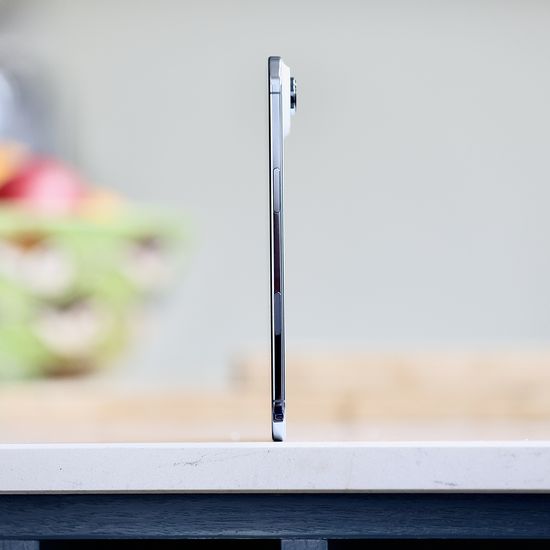By Adrian Weckler
Copyright independent

After a week of using it daily, I have a few main conclusions. (If you want to listen to a bit more of an in-depth discussion about my review, stream our special Apple review podcast episode this week, which goes into more depth.)
The basics are that this is the thinnest (5.6mm), lightest (165g), full-powered (A19 Pro chip), full-sized (6.5 inch ProMotion display) iPhone you can buy, with storage up to 1TB and costing from €1,239 (256GB). With one main exception, it does everything that a high-end iPhone should do, just in a much slimmer form factor.
Here’s the verdict.
1. It’s the nicest iPhone to actually use
There’s a quality in tech that is hard to measure in engine specifications, brightness nits, storage capacity or software. It’s the idea of ‘delight’. Think of your favourite watch. Or the first time you experienced great headphones. Or the pleasure you get from using a vinyl record player.
Most of us have at least one device that we don’t just admire, but actively, genuinely like.
Apple has been unusually good at delivering on this ephemeral quality over the last quarter century, whether it’s the orange and green iMacs from the last 90s to thin MacBook Airs and iPhones in the late 2000s to AirPods after that.
The iPhone Air does have some of this going on and it’s only really apparent when you pick it up and start using it. Because it’s so thin (5.6mm) and light (165g), it feels somehow more effortless to use in one hand, especially compared to the Pro and Pro Max models I usually handle. It becomes less of a computer and more of an extension, with less stress on pockets, too. And this is despite it having a bigger, 6.5-inch, 3,000-nits-bright ProMotion display than either the 6.3-inch iPhone 17 or iPhone 17 Pro models (both of which I’ve reviewed separately).
I’ve loved actually using it for my normal stuff, including work, web and social media; I can immediately feel the extra weight when going back to another phone.
2. It’s rock solid, physically
Probably the biggest question I’ve fielded about the iPhone Air is around durability. Because it’s so thin, mightn’t it be more susceptible to bending or stress?
The answer, from my experience, is no. I’ve tried to bend it, using almost as much force as I could (I’m no Schwarzenegger but am no George McFly, either). Not a hint of give. This may be because of the titanium that Apple uses in the Air’s casing. In fact, it’s the only one in the iPhone 17 lineup to retain the (tougher) titanium material as part of its design, with the other iPhone 17 models switching to aluminium.
When I first saw it at its launch last week, I attended a demonstration where significant industrial pressure was put on the device to show how robust the titanium casing makes it. This thing won’t break or bend.
Apple has also imbued the display with ‘Ceramic Shield 2’ material which, it claims, makes it three times more resistant to scratches compared to the iPhone 16.
3. Its battery is good enough for normal usage, but maybe not power usage
I tend to heap a lot of activity on my phones, especially on days when I’m outside taking photos or shooting videos (and then editing them or posting them).
In my testing, the iPhone Air was some distance off what the iPhone 17 Pro and iPhone 17 Pro Max achieved (although, as my review of those models points out, they are exceptional battery performers). In other words, I tended to get to 8pm with somewhere between 15pc and 30pc left, depending on what kind of a day I had. That would represent around five hours of screen-on time and varying app, online or camera usage.
I was expecting something a little worse than that, so it was somewhat of a pleasant surprise. The most challenging day was when I used it a lot outside in the sunshine — it isn’t as good as the other iPhones, I found, at dealing with the battery strain of maximum screen brightness. But I’m pretty confident that this would be enough for most people doing normal things.
If not, Apple has also released a special, customised, iPhone Air MagSafe battery (€115) that magnetically clicks on to the back of the phone and gives it an extra 50pc or so. This might be seen as defeating the purpose of having such a thin, light phone in the first place. But my guess is that it’s something you can use occasionally when you know you’ll be putting more pressure on the phone’s battery.
4. The rear camera is very good, but I miss having more than one lens option
Maybe the biggest compromise the iPhone Air makes to achieve its insane skinniness is the lack of multiple rear cameras. Instead of two (iPhone 17) or three (17 Pro) lenses, there’s just a single, 48-megapixel (1x) snapper. It’s the same ‘Fusion’ camera as on the iPhone 17 and the quality from it is actually very good; as well as doing a decent job of (digitally) zooming in to 2x or even 4x, it can handle portrait shots reasonably well using its software (via its portrait mode). Apple has also included its Camera Control button here, which is pretty impressive as it could easily have justified dropping it due the phone’s skinniness.
Video quality, as has become customary in iPhones, is excellent, with surprisingly good stabilisation and 4K shooting at up to 60 frames per second. There’s a new video-shooting feature called ‘dual capture’ which lets you use both rear and selfie cameras at once, showing a thumbnail video of the shooter (you) in any corner of the frame as you video whatever’s in front of you.
Anyone who shoots the majority of their photos or videos in the usual focal lengths will likely be very happy with this camera setup. But if extended photography options — especially ultrawide and optical telephoto zoom — are important to you, you’re better off going with a 17 Pro model or even the regular 17 model.
5. The new selfie camera is very useful
One big difference that Apple has made to all of the front-facing (selfie) cameras on the 2025 iPhone range is a square camera sensor.
The effect of this is that when you’re using the selfie lens, it can take a photo in either landscape (horizontal) or portrait (vertical) modes (you switch by simply tapping on the screen). For frequent selfie-takers, the big advantage to this is that it’s easier to hold the phone when taking a landscape selfie — you neither have to awkwardly hold the phone on its side, one-handed while trying to snap the selfie with a forefinger, or hold two arms out for landscape selfies with the awkward results in the photo.
The 18-megapixel selfie camera now also has Apple’s Centre Stage feature, which iPads and MacBooks have had for a while. This ‘centres’ your head close to the middle of the photo, even if you move around a bit, utilising the unused parts of the ultra-wide selfie camera. It also recognises when other people enter the frame (for a group selfie) and works to position the best shot in the same way.
6. It’s eSim only, restricting your operator choices (a little)
In the US, all iPhones sold are eSim-only, meaning that you can’t put your normal plastic sim card into one — it has to be activated digitally through an operator. This is the first phone on the Irish market to be eSim-only. In Ireland, Vodafone, Three, Eir and Gomo all support eSims, but 48, Tesco Mobile and Clear Mobile don’t. Vodafone has a process that lets you switch your account from your old (plastic sim) iPhone to an eSim iPhone yourself. The other operators vary in how it’s done.
I downloaded a €20-per-month, ‘all you can eat’ Three eSim to the device in a couple of minutes without any problem.
7. It’s very fast and powerful
Apple has put its fastest-ever chip in this phone, the ultra-powerful A19 Pro, making it faster than the iPhone 17 and just a hair behind the iPhone 17 Pro Max (on GPU score). It also gets 12GB of Ram, 50pc more than the iPhone 17 and on par with the iPhone 17 Pro and Pro Max models. This is a real statement about the iPhone Air as a completely capable, future-proofed model and not just a pretty device.
8. I love that it gets 1TB of storage
I can easily see how Apple could have limited the Air to 512GB of storage, classifying the device as something of an aesthetic model and reserving 1TB (or 2TB, as with the 17 Pro Max) for the beefier devices. But no, it’s configurable up to 1TB (€1,739), which is twice as much as the top storage level of the iPhone 17.
The iPhone Air comes in four colours, from sky blue (my test model) to space black. It costs €1,239 (256GB), €1,489 (512GB) or €1,739 (1TB).



